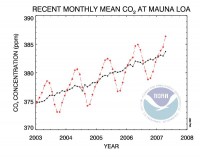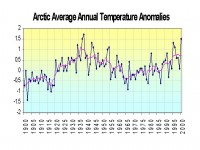By Joseph D’Aleo, CCM
A story in the UK Independent reported on three papers or stories timed to urge more drastic action by the G-8 in their upcoming Climate Change summit. The story said the changes occuring were far worse than even the most extreme IPCC scenario and thus warranted immediate and strong action. Lets take a look at the claims made.
One study, published by the US National Academy of Sciences, shows that carbon dioxide emissions have been increasing by about 3 per cent a year during this decade, compared with 1.1 per cent a year in the 1990s. Despite this reported increase in emissions, the atmospheric concentrations have NOT accelerated. The rate of change in 2006 was 0.44% which is virtually unchanged through the entire Mauna Loa record since 1959. This is proof that sinks such as the oceans and the land vegetation are able to fully sequester most of man’s input, which is minute compared to the natural sources (2.75% of the 0.0038% global atmospheric content of CO is just 0.12%). For a 100 story building, man’s input is the equivalent to the thickness of the linoleum on the bottom floor. It has been shown by Segalstad that even if you burned all of the fossil fuels on the planet at once, the CO2 would not increase more than 20%, it could never double. See Tom’s story and Tom’s PPT.

The story also quoted a study by the University of California’s National Snow and Ice Data Center shows that Arctic ice has declined 3 times faster since the 1950s than shown by the models. The actual temperature changes as measured by Polyakov and Dmintrenko (2003) are cyclical and along with the ice thinning and shrinking is similar to that last warm period in the 1930s and 1940s. Even the IPCC noted the changes were similar to the warming of the 1930s and 1940s. Even if all the arctic ice were to melt, it would not accelerate sea level rises because the ice is floating. That is why your glass of ice tea doesn’t overflow when the ice melts. The cycles in arctic temperatures (and US and Greenland) have been observed to extend back centuries. We showed in this blog paper and this paper the cyclical and primarily natural factor driven behavior of temperatures in these regions.
Without major Greenland melting and Antarctic melting (both largely discounted even by the IPCC AR4), there will be no accelerated sea level rise. Indeed Holgate and Woodworth (2004) calculated that the mean rate of global sea level rise was “larger in the early part of the last century (2.03 ± 0.35 mm/year 1904-1953), in comparison with the latter part (1.45 ± 0.34 mm/year 1954-2003).”





